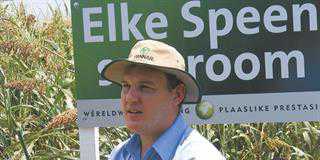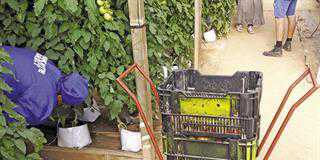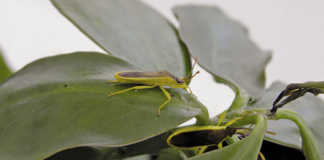Dung beetles can restore the health of farming ecosystems, reports Cornelia du Plooy. But their survival is threatened by toxic anti-parasitics. A toxicity rating system for animal health products now gives farmers an indication of how to use these products safely.
In Egyptian mythology the scarab beetle was Lord Khephera, god of rebirth, creative energy and eternal life. Today, both farmers and conservationists hold scarabs in the highest regard. Their dung-burying not only improves soil fertility, aeration and water penetration, but also prevents the accumulation of breeding media for pests and parasites like flies, ticks and nematodes.
The scarabs’ vital role was recently brought under the spotlight at a workshop held by the Dung Beetles for Africa Organisation, hosted by the University of Pretoria’s Zoology Department. All the assembled experts, from scientists to leading cattle farmers, agreed that the use of toxic anti-parasitics should be limited. In the dung of animals treated with these anti-parasitics, the residual toxicity is killing off dung beetles. A lready in the US, forage has been fouled by dung pads left unprocessed because of a lack of dung beetles.
This has resulted in annual losses of 0 million, and an explosion in dung-breeding parasites and fly populations, causing higher parasite infestation in livestock and even human infant mortality. “Farmers are faced with yet another growing dilemma – increasing tick and nematode resistance to anti-parasitics, which in turn demands more potent and longer lasting poisons,” warns the University of Pretoria’s Dr Ute Kryger. In turn, these more expensive anti-parasitics have serious environmental impacts, particularly on dung beetles.
Drive to reduce toxicity
“We aim to determine the environmental toxicity of available anti-parasitics, inform the farming community about their ecological toxicity and publicise the importance of dung beetles in agro-ecosystems,” says Kryger. If the use of anti-parasitics toxic to dung beetles is reduced, effective dung beetle communities will be able to process dung, reduce parasite breeding grounds and improve pasture health and productivity, as well as parasite-borne diseases of both livestock and people. Increased animal health will also lead to increased annual turnover. “Very few of the anti-parasitic chemicals available to local farmers have ever been tested against dung beetles or under local conditions,” says Kryger.
In 2003, local ecotoxicological anti-parasitic screening work led the University of Pretoria to register a dung-beetle-friendliness trademark. This indicates the effect of anti-parasitic products on non-target species with a star rating system. “Novartis Animal Health has become the first manufacturer to subject its cattle anti-parasitic products to assessment,” says Kryger. The absence of the trademark means that the product hasn’t been tested for non-target toxicity. One star means the product’s use should be limited to stock feedlots, and it shouldn’t be used in pastures. Two stars means the product is suitable for occasional use in the pasture, while three stars means the product has a minimal impact on dung beetles and is considered suitable for regular use in the pasture. For more information, contact Carmen Jacobs or Werner Strumpher at the Scarab Research Group, Department of Zoology & Entomology, University of Pretoria on (012) 420 3754, fax (012) 362 5242, or e-mail [email protected].
Port Jackson trumped
Wouter Kriel reports that the Acacia gall rust fungus is proving itself as a biological weapon in the battle against the invasive Port Jackson. Port Jackson (Acacia saligna) is a serious invasive weed in the Western and Eastern Cape low lands. It forms dense stands, threatens water sources and biodiversity and encroaches on agricultural land. In 1987 the Acacia gall rust fungus (Uromycladium tepperianum) was introduced to stem the invasion biologically. This fungus occurs naturally on Port Jackson in Australia, but since it only attacks grown trees, it was absent in the seeds shipped to South Africa in the 1800s to stabilise sand dunes in the southern and western Cape.
Alan Wood and others from ARC-Plant Protection Research Institute have been monitoring the success of the gall rust fungus over 15 years at selected sites in the Western Cape. “weed’s densities have declined between 85% and 98% at the monitoring sites,” says Wood. “Canopy mass and seed production are also lower, with many plants dying within two years of germinating. Few live longer than seven years.”
Reduced densities are now opening up grazing land again, and the reduction in leaf litter lowers the intensity of fires. Indigenous plants are also returning, but Wood notes that the increased nitrogen levels in the soil, caused by the legumous weed, prevent fynbos or renosterveld from returning immediately. Landowners therefore need to actively implement reintroduction strategies for results.
Landowners are obliged to control Port Jackson by law. When biological and mechanical controls are combined, the results can be encouraging and financially viable, says Barend le Roux from CapeNature.
Extermination tips
Mechanical control entails felling, frilling or ring-barking adult trees. “Trees should be felled as close to the ground as possible, and the stumps treated with prescribed herbicides,” says Le Roux. ”Frilling entails cutting through the bark until the cambium is reached. Herbicide is then applied to the cut. With ring-barking a cut of 30cm in width is made around the circumference of the trunk. The bark is removed, and herbicide is applied.” “Start with young trees in less dense stands to arrest an invasion and prevent the build up of seed banks,” says le Roux.
Since Port Jackson seeds can survive in their dormant phase for many years, this is key to controlling the weed, says Wood. “Always give preference to follow-up treatment over initial clearing, as money and time has already been spent,” says le Roux. “Follow-up treatment is essential to stem further spread and growth. It should be scheduled twice a year, and it might take more than three treatments before a maintenance phase is achieved.” Dense stands should be left for last, as chances are that density won’t increase any further. Rather allow the gall rust fungus to reduce the number of trees before mechanical clearing is attempted, as this will save time and money. Also minimise soil disturbance when clearing, as this will activate the seed bank. Never attempt a clearing operation that will be too expensive to allow for follow up treatments, warns Wood, as this will only make the problem worse.
Landowners must also be careful not to let other aggressive invaders replace cleared Port Jackson, like black wattle (Acacia mearnsii), pines (Pinus spp.) and Australian myrtle (Leptospernum laevigatum). Fire is a double-edged sword. A fire might destroy the stand, but will also stimulate the germination of the seed bank, resulting in an even denser stand. What’s more, the new stand will be without the gall rust fungus, as this takes up to five years to have a noticeable impact. Ideally one should allow 10 years after a fire in a dense stand before a clearing operation is attempted, says Wood.
According to le Roux, the age of the stand also determines which clearing method should be used. “Seedlings could either be foliar-sprayed or hand-pulled. They’re most effectively sprayed during their active growth phase in early spring,” he says. S aplings and young trees in low-density stands should be felled and treated with herbicide. In high-density stands a high-pressure sprayer will be most effective. Le Roux mentions that correct nozzle choice for an even application at foliar height will enhance the effectiveness. Mature trees should be felled as low as possible and treated with herbicide. “Port Jackson may never be eradicated in South Africa,” warns Wood, “but if managed correctly, it can be brought under control, allowing land to reach its full potential.”
Contact Alan Wood on (021) 887 4690 or e-mail [email protected].













